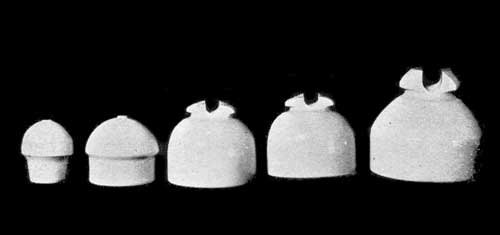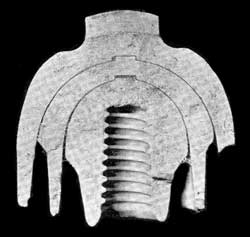[Trade Journal]
Publication: The Journal of Electricity
San Francisco, CA, United States
vol. V, no. 4, p. 76-77, col. 1-2
A MULTI-GLAZE INSULATOR.
It has been pointed out in papers read before the Pacific Coast Electric Transmission Association to the effect that the puncture resisting properties of a porcelain insulator for use on high potential lines depends largely, if not entirely upon the quality of the glaze with which it is covered and the thoroughness with which this glaze is applied. Some have contended that inasmuch as an insulator with chafed or damaged glaze is liable to absorb moisture and break down, the glaze alone constitutes its chief insulation and that to it, and not to porcelain must be attributed the puncture-resisting properties of the modern porcelain. Others, in admitting that this is so, go a step further and contend that inasmuch as glazing is but merely a coating of glass, why not make the insulator entirely of glass and be done with it. But the porcelain insulator is too strong a favorite to be supplanted with glass or any other material without a struggle and it must be admitted after reading the description of a new porcelain insulator, published below for the first time, that the insulator of ordinary form may be vastly improved upon and even made to closely approach the glass insulator as a puncture-resister without losing any of the advantages which porcelain possesses.
| |||
| The Boch Multi-Glaze Insulator. |
The Boch porcelain insulator for extremely high transmission voltages is made in three shells of porcelain of such sizes that one fits closely into the other and, after being cemented together, forms a solid insulator closely resembling the ordinary porcelain type in outward appearance. These three shells are glazed outside and inside most carefully, hence when they are put together and solidly cemented by a thin layer of melted glass, there are intervening between the wire and the pin, six skins of glaze and two layers of glass. In marked contrast to this is the ordinary insulator having but two skins of glaze between the wire and the pin.
| |||
| Elevation of Parts of the Boch Insulator. |
The advantages of the Boch insulator are manifest. It retains all the merits of porcelain as an insulating material; it is as impossible to puncture it as it is impossible to puncture glass, for, as is also the case with glass, extremely high potentials jump over the surface of the insulator to the pin rather than go through it. Moreover, injury to the glaze ruins a porcelain insulator of the ordinary form, while with the Boch insulator, should the outside shell absorb moisture, the two layers of glass, together with the remaining five layers of glaze, will unfailingly prevent the passage of current from wire to pin, in addition to making it absolutely impossible for the moisture to penetrate beyond the outer shell. It is surprising, too, how solidly the glass, to all intents and purposes, cements the three shells together into a single solid insulator. In the half-section illustrated, a six-inch insulator was split down from the groove on top by a cold chisel as effectively as though it were of solid porcelain.
| |||
| Sectional View of the Boch-Multi-Glaze Insulator. |
The cuts herewith were made from sections of the Boch insulators kindly loaned for the purpose by the California Electrical Works, San Francisco.



